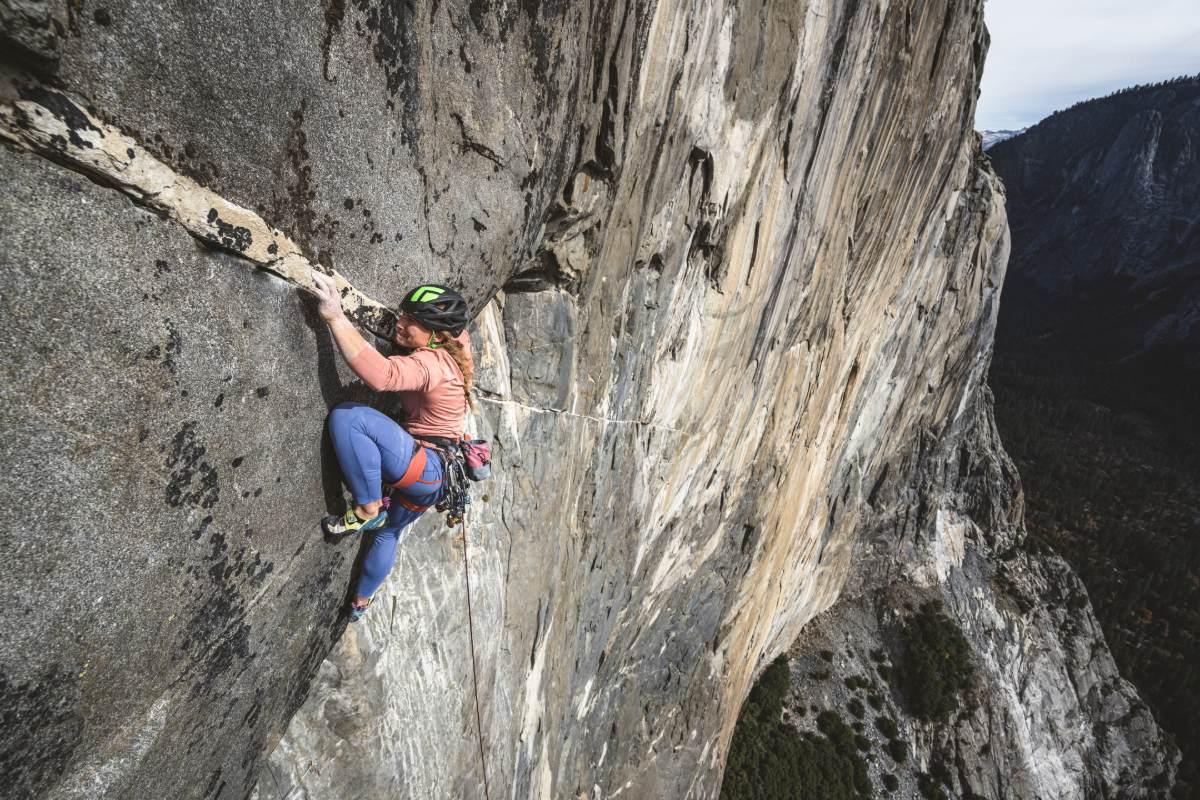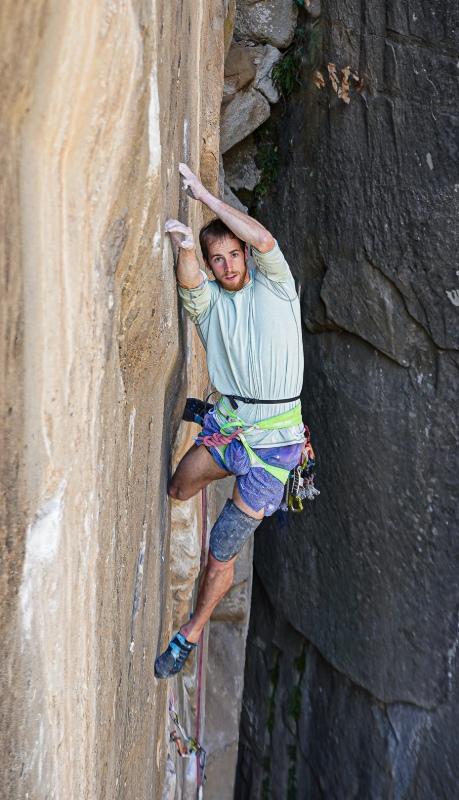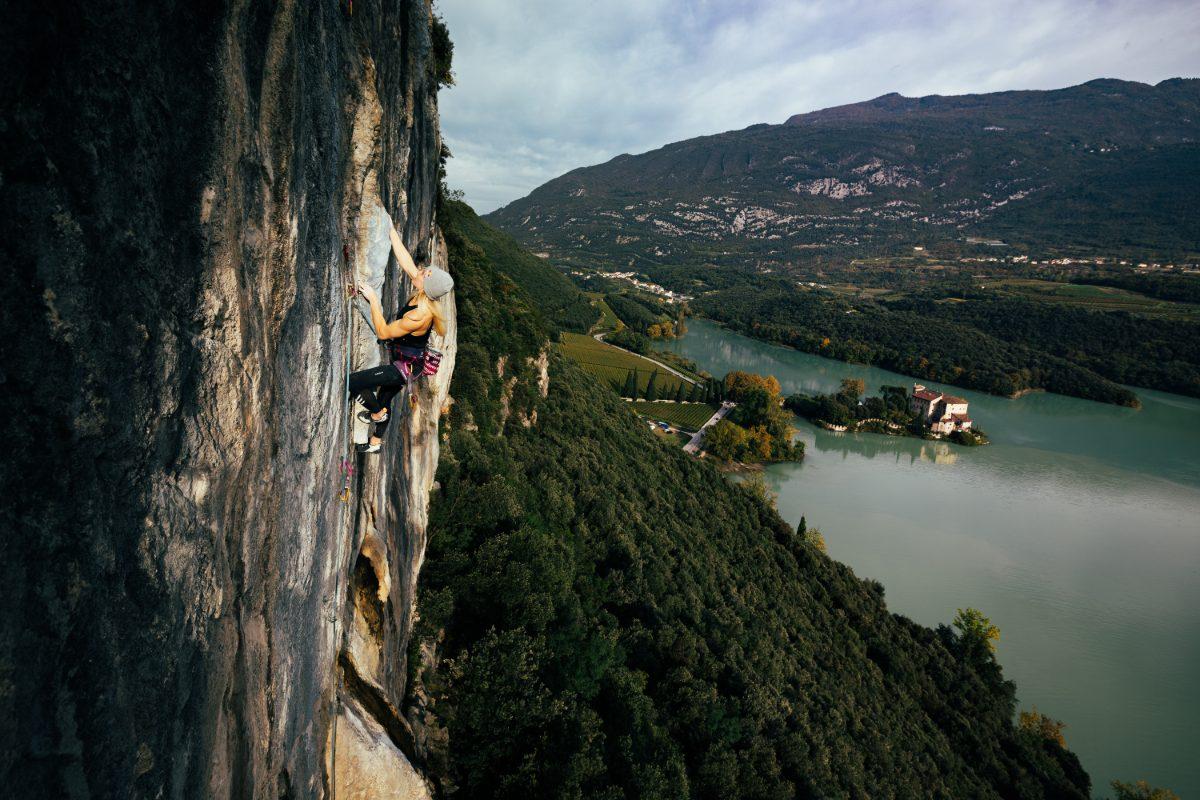Free climbing is the most widely practised form of modern climbing, yet it is often misunderstood. It is based on a simple principle: the climber ascends facing the rock using only physical strength and technique. The equipment (rope, quickdraws, helmet) is used solely for safety – never to aid climbing itself.

The difference between free climbing and free soloing
Despite what the name might suggest, free climbing has nothing to do with free soloing – a radical discipline practised without a rope, belay or protection. Free climbing is an often mistaken term, in this article, we’ll explore what free climbing really is, how it differs from other forms of climbing, its history, its main climbing styles, and how to get started in this demanding yet fascinating activity.
History and evolution of free climbing
Free climbing has its roots in the early 20th century, with pioneers such as Paul Preuss, who championed climbs without artificial aids. But it was during the 1960s to 1980s that free climbing truly broke away from aid climbing.
In the United States, John Gill laid the foundations of modern bouldering. In Yosemite Valley, Royal Robbins pioneered 'clean climbing', ascending without pitons in order to preserve the rock. In Europe, Kurt Albert introduced the ‘redpoint’ (rotpunkt): when a climber completed a full free ascent of a climbing route, they would mark the achievement by painting a red dot at the base. This symbolic gesture marked a turning point in climbing ethics.
The following decades saw the emergence of modern climbing shoes, dynamic ropes, and quickdraws with double wire gates – all innovations that made sport climbing more accessible, safer, and technically demanding.
What are the main differences between sport climbing, trad climbing and aid climbing?
Sport climbing
Sport climbing is the most widespread style. Climbing routes are equipped with fixed anchors drilled into the rock. The climber clips quickdraws into these as they move up, always climbing free. This allows climbers to push their limits of difficulty by focusing on movement, without the added pressure of placing protective gear.
Sport climbing is most often practised indoors in a climbing gym or on well-equipped crags. It’s ideal for improving your skills.
Trad climbing
In contrast, traditional climbing relies on placing removable protection (nuts, cams) directly into the rock. It requires a high level of expertise. This discipline captures the spirit of original free climbing, but involves a much greater psychological commitment.
This style is commonly found in mountain terrain or on natural, unbolted cliffs. It demands a solid understanding of your gear, the ability to read the rock, and strong anchor-building skills. A similar approach is used in ice climbing, where protection is placed in frozen waterfalls using ice screws. Climbers progress using ice axes and crampons, in winter conditions that add a demanding physical and technical dimension.
Aid climbing
Finally, in certain situations (blank walls, high fall risk, or routes that can’t be freed), climbers turn to aid climbing. In this method, upward progress is made by pulling on gear (pitons, ladders, slings). It’s a useful technique for exploration or equipping new climbing routes, but by definition it stands in contrast to free climbing.
Bouldering vs lead climbing: two complementary forms of free climbing
Bouldering
Bouldering involves climbing short walls (2 to 5 metres high) without a rope, using crash pads to cushion falls. This discipline focuses on pure difficulty: short, intense, highly technical moves. Climbers often repeat the same sequence until they complete it cleanly.
Accessible and fun, bouldering is also a discipline in its own right and is featured in competitions. It’s practised both indoors in climbing gyms and outdoors on natural rock. This discipline emphasises power and raw strength, whereas route climbing requires more precise footwork and greater endurance.
Route climbing/lead climbing
Route climbing refers to ascending taller walls that require ropes and a harness. The lead climber ascends and clips quickdraws into pre-placed anchor points along the way to protect themselves in case of a fall. These anchor points are installed by qualified professionals: mountain guides, certified instructors and other trained mountain professionals.
This type of climbing demands more endurance, strong route-reading skills, and excellent mental control.
There are several climbing styles for routes: sport or traditional, depending on whether the protection is pre-installed or placed by the climber.
Top roping is a style of climbing where the rope is anchored at the top of the climb and runs down to the climber, who is belayed from the ground. As the climber ascends, the belayer takes in slack, keeping the rope taut and minimizing fall distance. This method is commonly used in indoor climbing gyms and for beginner climbers because it provides a high level of safety and confidence.
Multi-pitch climbing is a type of rock climbing where the route is too long to be completed with a single rope length. It is divided into several 'pitches', or rope-length sections. Climbers ascend one pitch at a time, establishing belay stations at the end of each section where they secure themselves and belay their partner.

Indoor vs outdoor climbing: two environments, two approaches
Indoor climbing
Indoor climbing is ideal for learning the basics, refining your technique and climbing all year round. The setting is controlled, routes are clearly marked, and safety is supervised. You'll find bouldering areas, roped climbing routes and auto-belay systems.
For beginners, it’s the best place to start. You can get familiar with rope handling, belay systems, and work on your movement without having to worry about weather conditions.
Outdoor climbing
Outdoor climbing offers direct contact with real rock, breathtaking scenery – and its fair share of challenges: weather, route reading, and self-reliance. You need to adapt your gear, understand local grading systems, and sometimes adjust to a specific climbing style (smearing, crack climbing, etc.).
The difference between climbing indoors and outdoors goes beyond the setting – it’s also about sensations, commitment and unpredictability. Climbing outdoors teaches adaptability, self-awareness and responsibility.
For more insights into the differences between indoor and outdoor climbing, check out our dedicated guide: Indoor vs outdoor climbing
How to get started with free climbing: our tips to becoming a rock climber
Start gradually
Starting with indoor bouldering is a great way to learn basic movement without handling ropes. You can then move on to top-rope climbing, followed by leading routes. It’s recommended to take an introductory course or climb with an experienced partner.
For more general advice about climbing, check out our detailed tutorial: Everything you need to know about climbing: a complete guide for beginners and enthusiasts
Choose the right gear
The essential gear includes:
- a pair of well-fitting climbing shoes
- a harness
- a dynamic rope
- quickdraws (for lead climbing)
- a belay device
- a helmet (a must for outdoor climbing)
- chalk
It’s important to adapt your gear to the weather conditions and the terrain. On the crag, also take a route guide (topo) and a small first aid kit.
For a full breakdown of climbing equipment, check out our guide: What gear do you need to start climbing?
Set your goals
You don’t need to aim for a grade 8a to make progress. Set yourself goals that match your current level: finishing a route without falling, sending a tricky boulder problem, or leading a climb with confidence.
The key is to climb regularly, listen to your body, and enjoy every free climbing ascent. With time, your technique will improve, your confidence will grow, and you’ll naturally move on to harder climbs.
Free climbing is more than just a sport – it’s a school of patience, balance, and pushing your own limits. It’s rooted in a rich tradition, yet remains accessible to anyone who wants to experience the vertical world with confidence and freedom.
Whether indoors or out, on boulders or on climbing routes, each climbing style offers its own challenges and rewards. All it takes is to get started, progress at your own pace, and above all, never stop learning.
To learn more about the different types of climbing, look at our guide: The different disciplines of climbing

